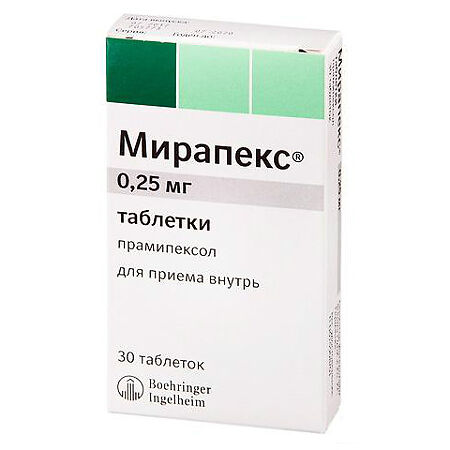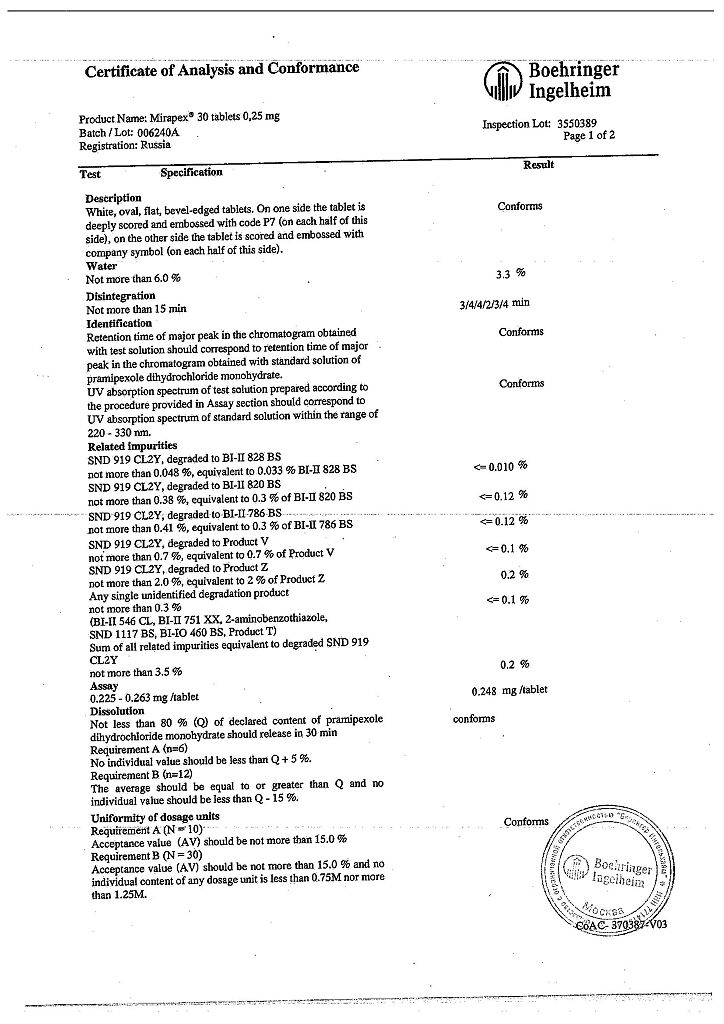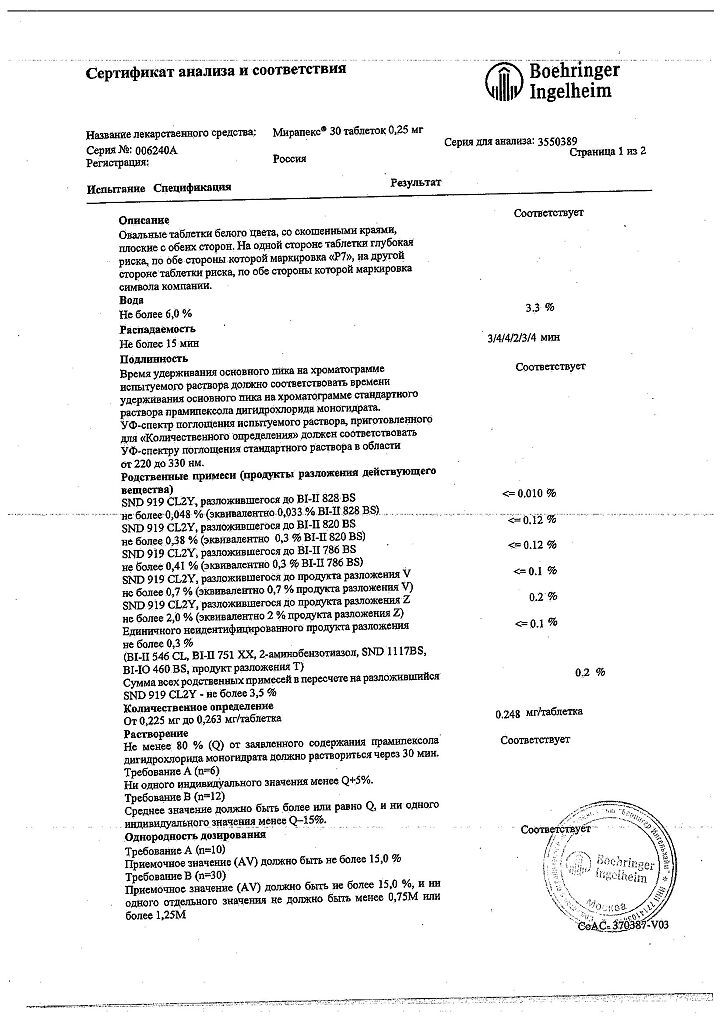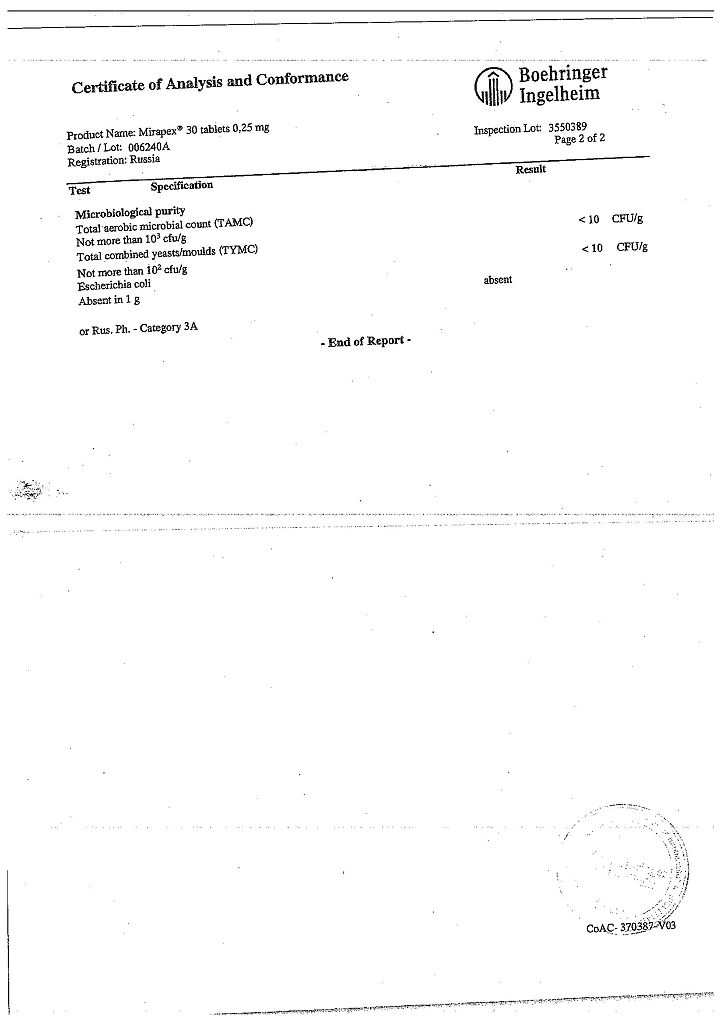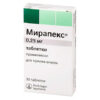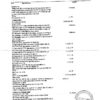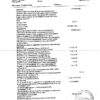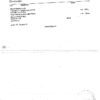No products in the cart.
Mirapex, tablets 0.25 mg 30 pcs
€7.91 €6.92
Description
Phramipexole is a dopaminergic, antiparkinsonian.
Pharmacodynamics
Pramipexole is a dopamine receptor agonist and binds with high selectivity and specificity to dopamine receptors of subgroup D2 group, of which it has the most pronounced affinity for D3 receptors. Reduces motor deficits in Parkinson’s disease by stimulating dopamine receptors in the striatum.
Pramipexole inhibits dopamine synthesis, release and metabolism. In vitro, pramipexole protects dopamine neurons from degeneration occurring in response to ischemia or methamphetamine neurotoxicity.
The drug’s exact mechanism of action in the treatment of restless legs syndrome is not currently known. Although the pathophysiology of restless legs syndrome is not fully understood, there is neuropharmacological evidence of primary involvement of the dopaminergic system.
Positron emission tomography (PET) studies have shown that moderate presynaptic dopaminergic dysfunction in the striatum may be involved in the pathogenesis of restless legs syndrome.
Pramipexole in vitro protects neurons from levodopa neurotoxicity.
Decreases prolactin secretion (dose-dependent).
In long-term use (>3 years) of pramipexole in patients with Parkinson’s disease, there was no evidence of decreased efficacy.
When pramipexole was used for 1 year in patients with restless legs syndrome, efficacy was maintained.
Pharmacokinetics
Pramipexole is rapidly and completely absorbed after oral administration. Absolute bioavailability is more than 90% and Cmax in plasma is observed after 1-3 hours. The rate of absorption is reduced with food, but total absorption is not affected by food intake.
Pramipexole is characterized by linear kinetics and relatively little variability in concentrations between patients.
Pramipexole binds very little to proteins (d(400L). It is metabolized to a negligible extent. About 90% of the dose is excreted through the kidneys (80% unchanged) and less than 2% is found in the feces.
The total clearance of pramipexole is about 500 ml/min, renal clearance is about 400 ml/min.T1/2 ranges from 8 h in the young to 12 h in the elderly.
Indications
Indications
Symptomatic treatment of idiopathic Parkinson’s disease (monotherapy or in combination with levodopa) and idiopathic restless legs syndrome.
Pharmacological effect
Pharmacological effect
Mirapex – dopaminergic, antiparkinsonian.
Pharmacodynamics
Pramipexole is a dopamine receptor agonist that binds with high selectivity and specificity to dopamine receptors of the D2 subgroup, of which it has the most pronounced affinity for D3 receptors. Reduces motor activity deficits in Parkinson’s disease by stimulating dopamine receptors in the striatum.
Pramipexole inhibits the synthesis, release and metabolism of dopamine. Pramipexole in vitro protects dopamine neurons from degeneration that occurs in response to ischemia or methamphetamine neurotoxicity.
The exact mechanism of action of the drug in the treatment of restless legs syndrome is currently unknown. Although the pathophysiology of restless legs syndrome is not fully understood, there is neuropharmacological evidence that the dopaminergic system is primarily involved in the process.
Studies using positron emission tomography (PET) have suggested that mild presynaptic dopaminergic dysfunction in the striatum may be involved in the pathogenesis of restless legs syndrome.
Pramipexole protects neurons from levodopa neurotoxicity in vitro.
Reduces the secretion of prolactin (dose-dependent).
With long-term use (more than 3 years) of pramipexole in patients with Parkinson’s disease, there were no signs of decreased effectiveness.
When pramipexole was used in patients with restless legs syndrome for 1 year, the effectiveness of the drug was maintained.
Pharmacokinetics
Pramipexole is rapidly and completely absorbed after oral administration. Absolute bioavailability is more than 90%, and Cmax in plasma is observed after 1-3 hours. The rate of absorption decreases with food intake, but the total amount of absorption is not affected by food intake.
Pramipexole exhibits linear kinetics and relatively little interpatient variability in concentrations.
Pramipexole binds to proteins to a very small extent (d(400 l). It is metabolized to a small extent. About 90% of the dose is excreted through the kidneys (80% unchanged) and less than 2% is found in the feces.
The total clearance of pramipexole is about 500 ml/min, renal clearance is about 400 ml/min. T1/2 ranges from 8 hours in young people to 12 hours in older people.
Special instructions
Special instructions
During treatment with pramipexole, episodes of sudden falling asleep during daytime wakefulness were observed. Drowsiness usually develops when using Mirapex in doses greater than 1.5 mg/day.
Episodes of sudden falling asleep against the background of daytime wakefulness occur against the background of already developed drowsiness. Factors that increase the risk of developing drowsiness include: concomitant use of sedatives, sleep disorders, concomitant use of drugs that increase the level of pramipexole in the blood plasma (for example, cimetidine).
Before prescribing Mirapex, the doctor must determine the presence of these risk factors. During therapy, it is necessary to monitor the patient’s condition to identify a tendency to drowsiness.
If severe daytime sleepiness develops or episodes of sudden falling asleep during daytime wakefulness occur that require active intervention, Mirapex should be discontinued. If it is necessary to continue therapy, the dose of the drug should be reduced and the patient should be advised to refrain from driving and other potentially hazardous activities.
During therapy with Mirapex, the incidence of arterial hypotension, as a rule, did not increase compared to placebo.
Elderly patients (65 years and older) require dose adjustment of Mirapex.
Since pramipexole is eliminated by the kidneys, dosage adjustments may be required in patients with kidney disease.
Impact on the ability to drive vehicles and operate machinery
The patient should refrain from driving and other potentially hazardous activities until the nature of the drug’s effect on the ability to concentrate and the speed of psychomotor reactions has been established.
Use in pediatrics
The safety and effectiveness of Mirapex in children has not been established.
Active ingredient
Active ingredient
Pramipexole
Composition
Composition
Active ingredient:
pramipexole dihydrochloride monohydrate 0.25 mg;
Excipients:
mannitol;
corn starch;
colloidal silicon dioxide;
povidone;
magnesium stearate.
Contraindications
Contraindications
Hypersensitivity to pramipexole or to any component of the drug;
children’s age (up to 18 years).
With caution: renal failure, decreased blood pressure.
Side Effects
Side Effects
From the central nervous system and peripheral nervous system: drowsiness, dyskinesia, hallucinations; in some cases – insomnia. With a rapid reduction in the dose of pramipexole, as well as with abrupt discontinuation of the drug, neuroleptic malignant syndrome was observed.
From the digestive system: nausea, constipation.
From the cardiovascular system: in some cases, at the beginning of treatment – arterial hypotension (especially with a gradual increase in dose over too short a time).
Other: in some cases – peripheral edema.
Interaction
Interaction
With the simultaneous use of Mirapex and levodopa, dyskinesia may develop (in such cases, the dose of levodopa should be reduced).
There is no pharmacokinetic interaction between pramipexole and selegiline.
When used simultaneously with cimetidine, an increase in the concentration of pramipexole in the blood plasma is observed.
Other drugs that are secreted by the renal organic cation transport system may also increase plasma pramipexole concentrations.
Overdose
Overdose
Symptoms: not established. There is no clinical experience with a significant overdose of Mirapex. One patient with a 10-year history of schizophrenia took 11 mg/day of pramipexole for 2 days; this is 2-3 times more than the daily dose recommended by the protocol.
No undesirable effects were noted due to the dose increase. Blood pressure remained stable, although heart rate increased to 100-120 beats/min.
Treatment: There is no known antidote for pramipexole. When symptoms of central nervous system stimulation appear, antipsychotics – derivatives of phenothiazine or butyrophenone – can be used, but the effectiveness of these drugs in eliminating the effects of an overdose of Mirapex has not been assessed.
When treating an overdose, maintenance therapy, gastric lavage, the use of agents for rehydration and detoxification of the body, and ECG monitoring may be required.
Storage conditions
Storage conditions
In a place protected from light, at a temperature not exceeding 30 °C
Shelf life
Shelf life
3 years
Manufacturer
Manufacturer
Boehringer Ingelheim Pharma GmbH & Co.KG, Germany
Additional information
| Shelf life | 3 years |
|---|---|
| Conditions of storage | In a light-protected place, at a temperature not exceeding 30 °C |
| Manufacturer | Boehringer Ingelheim Pharma GmbH & Co. |
| Medication form | pills |
| Brand | #Н/Д |
Related products
Buy Mirapex, tablets 0.25 mg 30 pcs with delivery to USA, UK, Europe and over 120 other countries.

